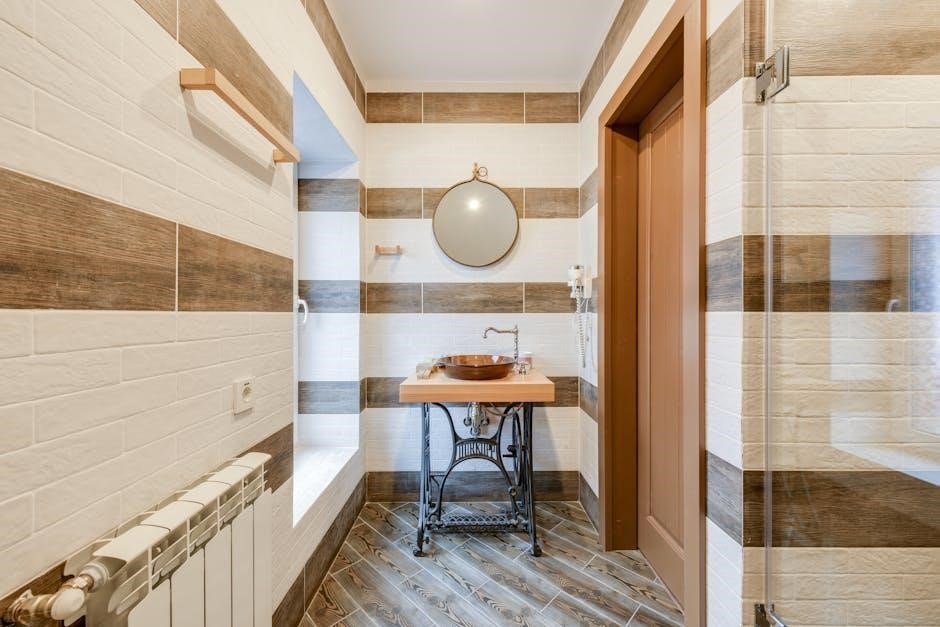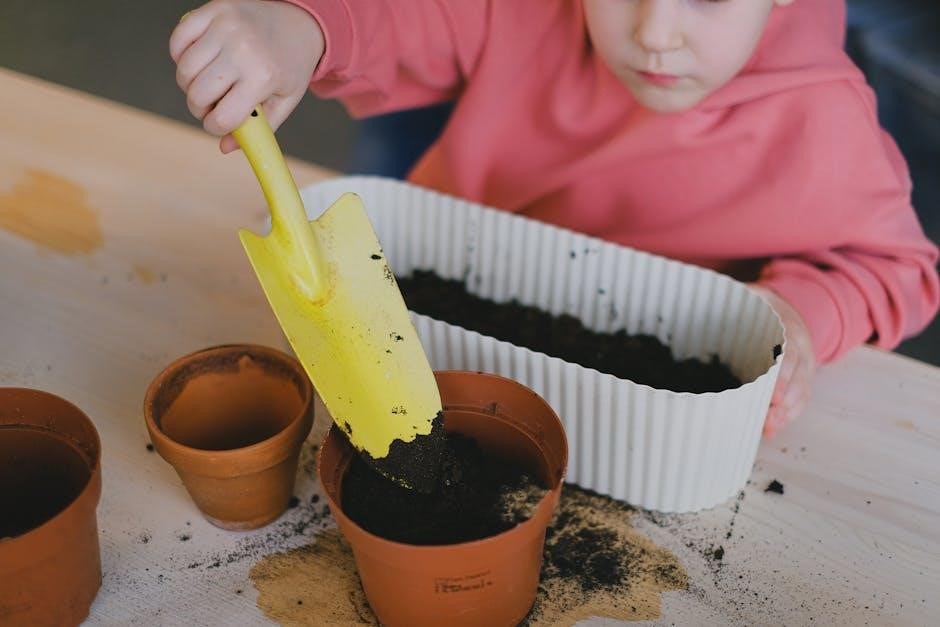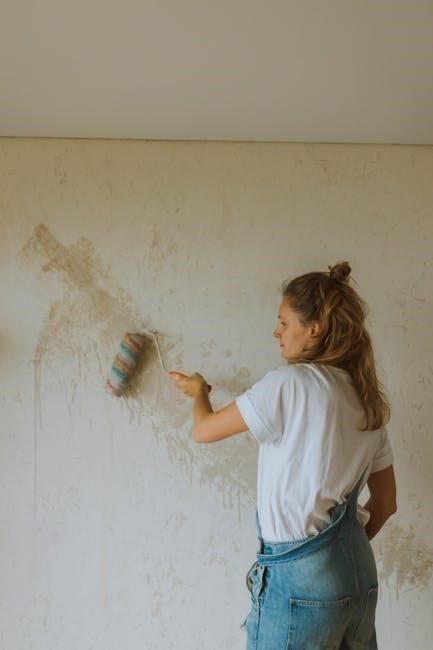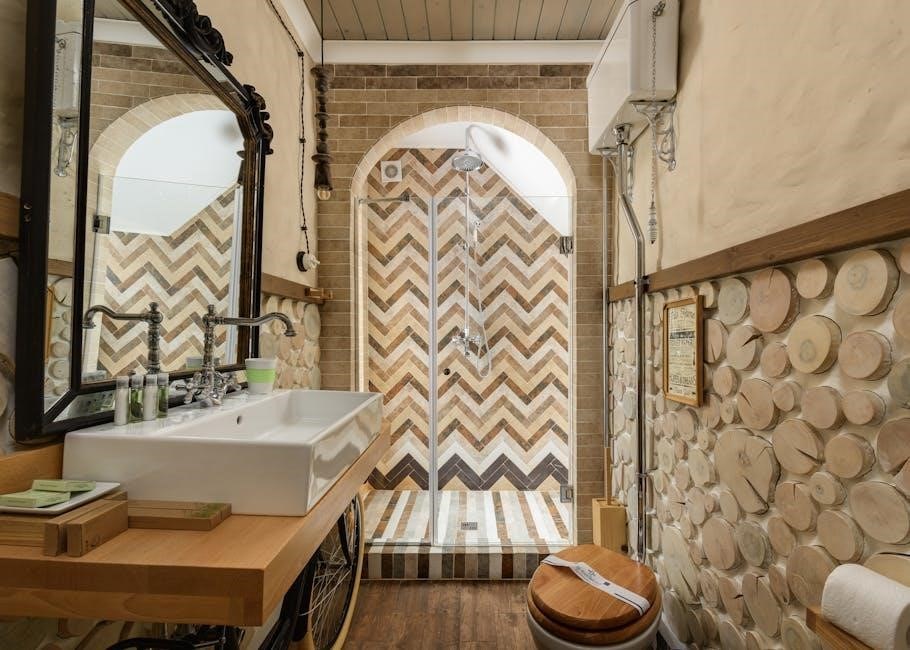Eco renovation is a sustainable approach to transforming homes, focusing on energy efficiency, waste reduction, and using eco-friendly materials to create healthier living spaces while minimizing environmental impact.
What is Eco Renovation?
Eco renovation is the process of transforming existing buildings to improve energy efficiency, reduce waste, and enhance sustainability. It involves retrofitting homes with eco-friendly materials, improving insulation, and integrating renewable energy systems. This approach aims to lower environmental impact while creating healthier, more comfortable living spaces. Eco renovation is about making intentional, sustainable choices that benefit both the planet and the occupants.
Why Eco Renovation is Important
Eco renovation is crucial for reducing environmental impact, cutting energy costs, and improving indoor health. It supports sustainability by minimizing waste and lowering carbon footprints. By retrofitting homes with energy-efficient systems and eco-friendly materials, eco renovation helps future-proof properties against rising energy prices and climate change. It also enhances property value and creates healthier, more comfortable living spaces for generations to come.

Planning and Budgeting for Eco Renovation
Start by defining clear goals and setting a realistic budget to balance eco-friendly choices with cost. Prioritize needs over wants to ensure sustainable, long-term benefits.
Defining Your Goals and Priorities
Begin by assessing your property’s current state and identifying what needs improvement. Set clear, achievable goals, such as reducing energy consumption or improving indoor air quality. Prioritize based on impact, cost, and sustainability. Consider your lifestyle and long-term benefits to ensure your eco-renovation aligns with both environmental and personal objectives. This step ensures a focused and effective approach to your project.
Setting a Realistic Budget
Start by researching material and labor costs to estimate expenses. Prioritize spending based on your goals, balancing upfront costs with long-term savings. Consider using budgeting tools or consulting professionals for accurate quotes. Allocate 10-20% of your budget for unexpected expenses. A well-planned budget ensures your eco-renovation remains financially sustainable and aligned with your environmental objectives without compromising quality.

Assessing Your Property
Evaluate your property’s energy efficiency and structural integrity to identify areas needing renovation. Inspect insulation, windows, and HVAC systems to determine where improvements are most beneficial.
Evaluating Energy Efficiency
Evaluating energy efficiency involves assessing your home’s current energy consumption and identifying areas of inefficiency. Conduct an energy audit to check for drafts, inspect insulation, and analyze HVAC performance. Look for gaps in windows, doors, and ductwork that may contribute to heat loss. Consider upgrading to energy-efficient solutions like double-glazed windows or smart thermostats. This step helps pinpoint where energy is being wasted and guides eco-friendly improvements.
Identifying Areas for Renovation
Begin by assessing your home for inefficiencies and damage. Check walls, windows, floors, and roofs for drafts or water leaks. Inspect outdated systems like plumbing and HVAC. Prioritize areas needing immediate attention, such as energy-inefficient windows or poor insulation. Focus on spaces that offer the most potential for energy and water savings. This step ensures your eco-renovation efforts target the most critical areas first, maximizing impact and sustainability.

Choosing Eco-Friendly Materials
Eco-friendly materials are sustainable, recycled, or naturally sourced, reducing environmental impact. They promote energy efficiency, durability, and healthier indoor air quality, aligning with eco-renovation goals.
Sustainable Material Options
Sustainable materials are eco-conscious choices that reduce environmental impact. Options include reclaimed wood, recycled metal, bamboo, and low-VOC paints. Natural materials like clay, straw bales, and cork are also popular. These materials are durable, energy-efficient, and promote healthier indoor air quality. Using locally sourced or FSC-certified products further minimizes carbon footprint. Sustainable materials align with eco-renovation goals, offering both aesthetic and environmental benefits for eco-friendly home transformations.
Where to Source Eco-Friendly Materials
Eco-friendly materials can be sourced from local suppliers, sustainable retailers, or online marketplaces specializing in green products. Consider reclaimed material stores, salvage yards, or organizations certified by bodies like the Forest Stewardship Council (FSC). Online platforms and local classifieds often list recycled or sustainably sourced options. Additionally, community groups or forums may offer leads on eco-conscious suppliers, ensuring your renovation aligns with environmental goals while supporting ethical practices.

Energy Efficiency in Eco Renovation
Energy efficiency is crucial for reducing energy consumption and costs. Key strategies include improving insulation, upgrading windows, and installing renewable energy systems to optimize performance and sustainability;
Improving Insulation
Improving insulation is a key step in eco renovation, reducing heat loss in winter and heat gain in summer. Focus on attics, walls, and floors, using eco-friendly materials like recycled fiberglass or natural wool. Proper insulation lowers energy bills and minimizes environmental impact. Sealing gaps and ensuring airtightness further enhances efficiency, creating a comfortable and sustainable living space while reducing carbon footprint.
Upgrading Windows and Doors
Upgrading windows and doors is crucial for energy efficiency in eco renovation. Opt for double or triple-glazed windows to reduce heat loss and minimize drafts. Choose materials like FSC-certified wood or fiberglass for durability and sustainability. Ensure proper sealing to prevent air leaks and enhance insulation. Consider passive design principles, such as strategic window placement, to maximize natural light and ventilation, reducing the need for artificial heating and cooling systems.
Installing Renewable Energy Systems
Installing renewable energy systems is a key step in eco renovation, reducing reliance on non-renewable resources. Solar panels, wind turbines, and geothermal systems are popular options, offering sustainable energy solutions. These systems lower energy costs, reduce carbon emissions, and promote energy independence. Consider assessing your property’s energy needs and local regulations before installation. Integrating renewable energy enhances your home’s eco-friendliness and long-term sustainability, making it a worthwhile investment for environmentally conscious homeowners.

Water Conservation Tips
Water conservation tips involve installing low-flow fixtures, using greywater systems, and harvesting rainwater to reduce consumption. These strategies help lower water bills and minimize environmental impact.
Low-Flow Fixtures and Greywater Systems
Low-flow fixtures, such as showerheads and toilets, significantly reduce water consumption. Greywater systems recycle water from sinks and washing machines for irrigation or flushing toilets, saving potable water. These eco-friendly solutions lower utility bills and promote sustainable living, making them essential for eco renovations.
Harvesting Rainwater
Harvesting rainwater involves collecting and storing rain for irrigation, flushing toilets, or washing machines. This eco-friendly practice reduces reliance on mains water, lowering bills and supporting sustainable living. Simple systems include roof catchments, gutters, and storage tanks. Regular maintenance ensures water quality and system efficiency, making it a practical and environmentally beneficial addition to eco-renovation projects.

Indoor Air Quality
Indoor air quality focuses on creating healthier living spaces by improving ventilation, reducing pollutants, and using non-toxic materials, enhancing overall comfort and sustainability.
Natural Ventilation Strategies
Natural ventilation strategies involve designing homes to maximize fresh air flow, reducing reliance on mechanical systems. Techniques include cross-ventilation, solar chimneys, and strategically placed windows and vents to enhance airflow. These methods not only improve indoor air quality but also reduce energy consumption, creating a healthier and more sustainable living environment while minimizing the need for air conditioning and heating systems.
Using Non-Toxic Paints and Materials
Using non-toxic paints and materials is essential for creating a healthy indoor environment during eco renovation. Opt for low-VOC (volatile organic compound) or VOC-free paints, natural finishes, and materials like organic wool, bamboo, and FSC-certified wood. These choices minimize harmful emissions and promote better air quality, ensuring a safer and more sustainable living space while supporting eco-friendly practices and reducing environmental impact.

DIY vs. Hiring Professionals
Eco renovation projects often require deciding between DIY and hiring professionals. DIY can save costs but may lack expertise, while professionals ensure quality and compliance with eco standards.
When to DIY and When to Hire Experts
Eco renovation projects often require balancing DIY efforts and professional expertise. Simple tasks like painting or insulating can be DIY, saving costs. However, complex projects such as installing renewable energy systems or retrofitting require skilled professionals to ensure safety and efficiency. Assess your skills and time availability to decide. Hiring experts guarantees compliance with eco standards and avoids costly mistakes, especially for critical systems.
Finding Reliable Contractors
Finding reliable contractors is crucial for a successful eco renovation. Seek recommendations from trusted sources and check reviews online. Ensure contractors have certifications in eco-friendly practices, such as Passive House or similar standards. Verify their experience with sustainable materials and energy-efficient systems. Always request detailed quotes and compare them. A reliable contractor will also provide guidance on complying with local regulations and achieving your eco goals effectively.

Maintaining and Monitoring Your Eco Renovation
Regular maintenance ensures your eco-friendly systems operate efficiently. Monitor energy and water usage with smart meters, and schedule annual professional check-ups to maintain performance and sustainability.
Regular Maintenance Tips
Regular maintenance is crucial for sustaining eco-renovation benefits. Inspect insulation, HVAC systems, and renewable energy setups annually. Clean solar panels and check for air leaks to ensure efficiency. Monitor water conservation systems like greywater and rainwater harvesting. Replace filters in eco-friendly appliances and check for mold or moisture issues. Keep track of energy and water usage through smart meters to identify areas for improvement and ensure long-term sustainability.
Monitoring Energy and Water Usage
Monitoring energy and water usage is essential for maintaining eco-renovation benefits. Install smart meters to track real-time consumption and identify inefficiencies. Regularly review utility bills to ensure savings align with eco-friendly upgrades. Use water tracking apps or devices to optimize greywater and rainwater systems. Conduct seasonal checks on renewable energy systems like solar panels to ensure peak performance and adjust usage habits for long-term sustainability and reduced environmental impact.